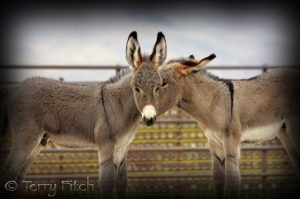Posted: June 15, 2012 by R.T. Fitch in Horse News, Wild Burros
Tags: Arizona, BLM, Bureau of Land Management, Cattoor, Cruelty to animals, wild burro
by Michelle Faust as published on Fronteras.com
Wranglers use rattles and flags to push the animals into a holding pen, from there they’ll be loaded on to vehicles that will transport them to Ridgecrest, Calif. where they will be prepared for adoption.
Since 1971, the Bureau of Land Management has been removing horses and burros from the wild across the Western United States. Burros in Arizona are believed to have been set free by miners in the 19th century.
John Hall is the Wild Horse and Burro Specialist for the local BLM. He said the goal is to gather 350 of the 711 burros in this area. Hall said they are a non-native species that pose a threat to other flora and fauna.
“These animals are over utilizing the native vegetation that the wildlife here depend on,” Hall said. “And when you have this overuse by the burros, it poses an immediate threat to the native wildlife.”
Conservationists dispute the number of burros the area can support and raise concerns about the use of helicopters for rounding them up in the Southwestern Arizona heat.
Congressman Raul Grijalva wrote a letter to the Secretary of the Interior requesting the animals not be gathered at temperatures above 90 degrees. This year, the policy was changed to stop corralling before temperatures hit 95.
Susanne Roy of the American Wild Horse Preservation Campaign said that’s a move in the right direction.
“We need a little bit of a more of a hands-off approach to let them regulate naturally. And then in those situations where they are not regulating naturally, we will then need to use a fertility vaccine to assist in that process,” Roy said. “And this will be a far more humane approach than these brutal round-ups every four years.”
Sue Cattoor is the contractor managing the roundup for the BLM. She said the helicopters do not put as much stress on the equine as people might imagine.
“[The animal learns] to respect that helicopter, but he’s not really afraid of it,” Cattoor said. “He knows it’s back there and he’s going to keep moving away from it because they’re a flight animal, but he’s not terrified like people think they are of ‘em.”
Traditionally the wild burros have had a near 100 percent adoption rate, but this year it’s less; 900 unadopted burros are in holding facilities with the BLM.
“We need a little bit of a more of a hands-off approach to let them regulate naturally”
YUMA, Ariz. — Early morning on the Colorado River, you expect to see boats and hear a few mosquitoes; It’s rare to see boatloads of wild burros. Wranglers have driven these animals for the last several days with helicopters and on horseback, but today they are unloading the grey equine off of a barge.Wranglers use rattles and flags to push the animals into a holding pen, from there they’ll be loaded on to vehicles that will transport them to Ridgecrest, Calif. where they will be prepared for adoption.
Since 1971, the Bureau of Land Management has been removing horses and burros from the wild across the Western United States. Burros in Arizona are believed to have been set free by miners in the 19th century.
John Hall is the Wild Horse and Burro Specialist for the local BLM. He said the goal is to gather 350 of the 711 burros in this area. Hall said they are a non-native species that pose a threat to other flora and fauna.
“These animals are over utilizing the native vegetation that the wildlife here depend on,” Hall said. “And when you have this overuse by the burros, it poses an immediate threat to the native wildlife.”
Conservationists dispute the number of burros the area can support and raise concerns about the use of helicopters for rounding them up in the Southwestern Arizona heat.
Congressman Raul Grijalva wrote a letter to the Secretary of the Interior requesting the animals not be gathered at temperatures above 90 degrees. This year, the policy was changed to stop corralling before temperatures hit 95.
Susanne Roy of the American Wild Horse Preservation Campaign said that’s a move in the right direction.
“We need a little bit of a more of a hands-off approach to let them regulate naturally. And then in those situations where they are not regulating naturally, we will then need to use a fertility vaccine to assist in that process,” Roy said. “And this will be a far more humane approach than these brutal round-ups every four years.”
Sue Cattoor is the contractor managing the roundup for the BLM. She said the helicopters do not put as much stress on the equine as people might imagine.
“[The animal learns] to respect that helicopter, but he’s not really afraid of it,” Cattoor said. “He knows it’s back there and he’s going to keep moving away from it because they’re a flight animal, but he’s not terrified like people think they are of ‘em.”
Traditionally the wild burros have had a near 100 percent adoption rate, but this year it’s less; 900 unadopted burros are in holding facilities with the BLM.










No comments:
Post a Comment